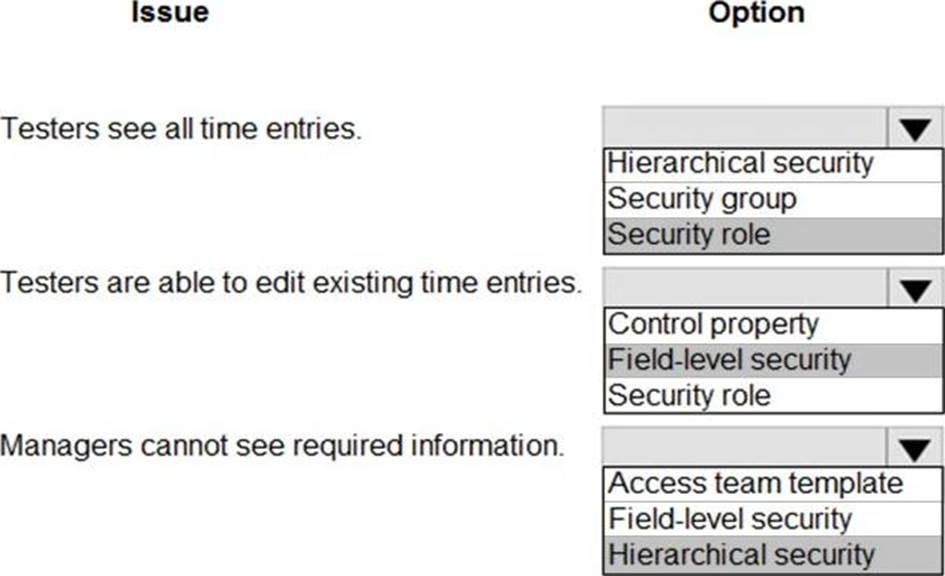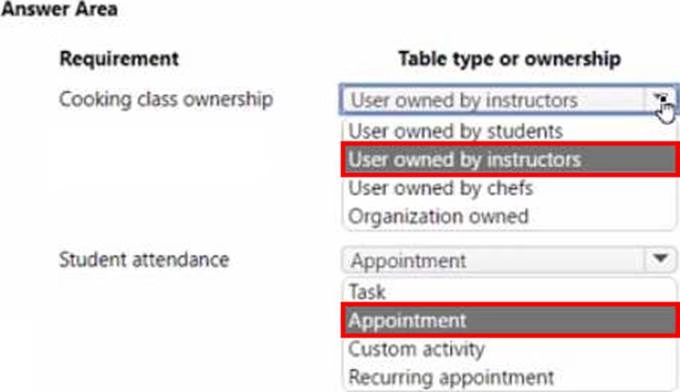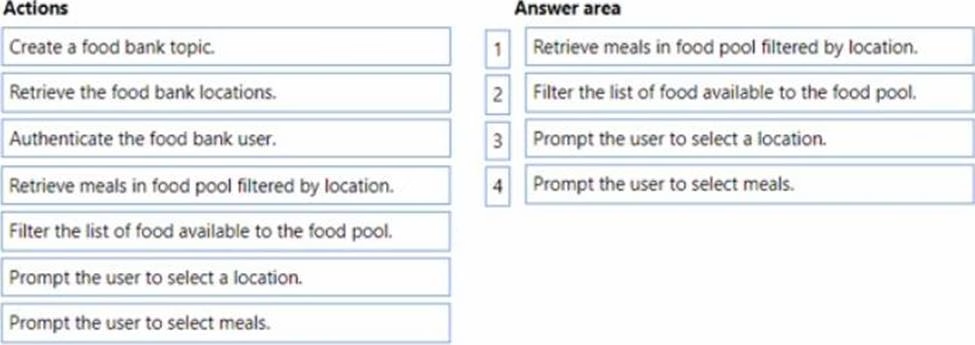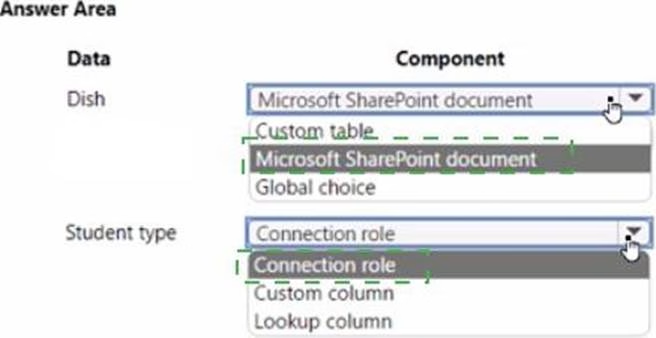Microsoft PL-100 Microsoft Power Platform App Maker (beta) Online Training
Microsoft PL-100 Online Training
The questions for PL-100 were last updated at Mar 07,2025.
- Exam Code: PL-100
- Exam Name: Microsoft Power Platform App Maker (beta)
- Certification Provider: Microsoft
- Latest update: Mar 07,2025
HOTSPOT
You need to configure the system to meet the sales requirements.
What should you do? To answer, select the appropriate options in the answer area. NOTE: Each correct selection is worth one point.

HOTSPOT
You need to resolve the issues found during testing.
Which option should you use? To answer, select the appropriate options in the answer area. NOTE: Each correct selection is worth one point.
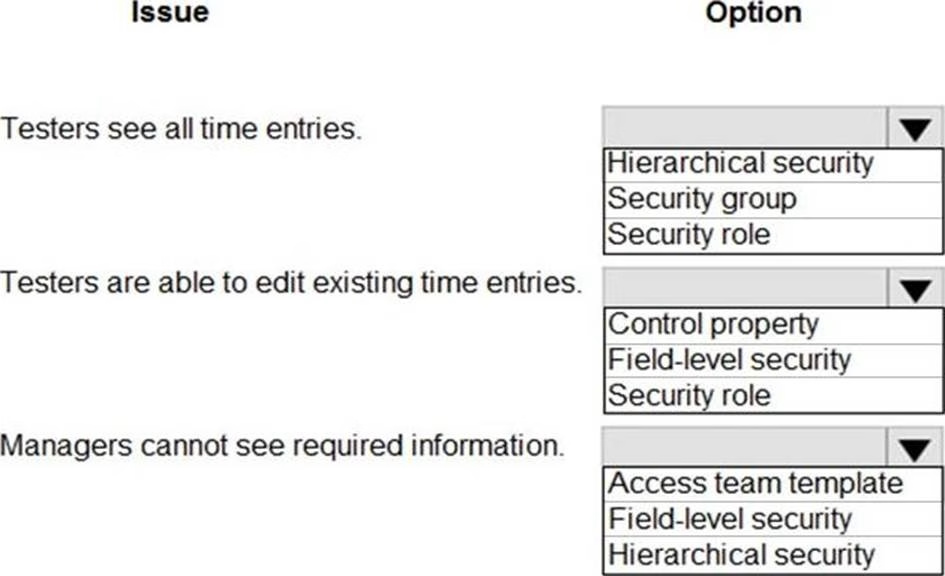
You need to resolve the user’s issue with the time tracking app.
Which two actions should you perform? Each correct answer presents part of the solution. NOTE: Each correct selection is worth one point.
- A . Add a component to the time tracking screen for tracking total time.
- B . Create a new component inside of the component library for the time tracking app.
- C . Upload the component to AppSource.
- D . Add the Total Time field to the screen and set the value of the field property to Rollup
You need to create a flow for moving data from the Sales Log to the Job Setup entity.
Which type of flow should you use?
- A . a scheduled flow for the Job Setup entity
- B . an instant (button) flow for the Sales Log
- C . a business process flow for the Job Setup entity
- D . an automated flow for the Sales Log
Topic 3, Culinary Arts College
Case Study
A culinary arts college trains world class chefs by offering a blend of theoretical and practical education. The culinary arts program enrolls two hundred students per term. The instructors split the students in groups of five to seven students, depending on the specialty selected. Each instructor is in charge of one group of students.
The college uses several systems to manage the student classroom activities. The college plans to implement a Microsoft Power Platform solution to replace the existing system. The goal is to align the cooking curriculum to the taste preferences of their subscribers and automate as much as possible to reduce administrative overhead. The college has two revenue streams:
• student enrollment fees and work placement brokerage
• lunch catering to businesses, school cafeterias and other consumers via subscriptions Subscribers place orders from a menu published by the instructors. The menu displays all the dishes and quantities that students will create during a cooking lesson.
The college partners with food banks to offer healthy meals to people in need. Students participate in the packaging and safe storage of any leftovers meals and notify the food banks about available meals. If 85 percent of the meals produced during a week sell out the college makes the remaining 15 percent available to food banks only.
Current system
• The college manages subscribers and their dish preferences by using a SQL Server-based app that is hosted in the college’s on-premises datacenter. Each week, data is extracted as a Microsoft Excel workbook and distributed to instructors.
• Recipes are stored as Microsoft Word documents in SharePoint libraries. Access to recipes is restricted to instructors and students.
• The college uses Microsoft 365 for emails, classroom and kitchen bookings, and document management.
• Students will use a Microsoft Outlook calendar to see their group’s schedule and to collaborate with instructors and other students.
Current processes
• Instructors use Microsoft Excel workbooks to capture class attendance information for cooking classes
• Instructors develop the culinary arts program and refine it periodically.
• Instructors are responsible for monitoring kitchen processes
• Instructors order the ingredients in bulk from food distributors. The instructors define threshold quantities that trigger inventory replenishment.
• Students self-organize in teams and brainstorm to produce new recipes.
• Students earn credits faster if they create new recipes in their specialty and the new recipe gains enough votes from subscribers
Cooking classes
• Each cooking class has a start date, a start and end time, a minimum and a maximum number of participants, and a cuisine specialty.
• Students select one main cuisine to specialize in when applying for enrollment
• Students participating in a cooking class can participate as a chef or as a helper. There is only one chef per session. Everyone else is a helper
• Instructors select the chef and recipe for each cooking class and distribute a link to the recipe document before each class.
• Each instructor performs quality checks on dishes that are offered for sale and evaluates both the chef and the helper.
Subscriptions
• The college offers the following types of subscriptions based on a client’s commitment to order
• Public – lunch orders placed between 1(h00 AM and noon from an open menu, subject to availability. Most occasional and high-volume subscribers became fans of the college after ordering from the public subscription,
o Occasional subscribers – a fixed number of meals, either monthly or weekly, o High volume – businesses that provide their staff free lunches every workday.
• A group of 25 business subscribers each order an average of 2.OO0 meals per day.
• The number of occasional subscribers varies daily.
• The college generates a QR code for high-volume subscribers to allow staff to vote for their favorite dishes.
Class management
• The solution must track credits earned by the students.
• Students require a fixed number of credits in the chefs role to gain the cuisine specialization. Students can acquire credits by using any of the following methods: o number of hours in practical sessions as helpers
o number of hours as chefs
o popular votes from dishes prepared as chefs o marks from the class instructor
• Students must confirm their attendance by selecting Start at the beginning of each class and selecting Done at the end of the class.
• The student s total number of practice hours and credits earned must display in the app
• Students team up together to create new recipes and must keep their recipes confidential.
• The instructors photograph dishes that pass quality checks and upload the photographs to the daily menu that is made available to subscribers.
• Dish votes are counted based on the number of people who marked the dish as a favorite.
• The college requires a lively visual that displays marketing data on their public-facing website.
Subscriptions
• The subscriber administrators must approve the credit terms for high-volume subscribers.
• Occasional and high-volume subscribers must be able to place orders online.
• Subscribers should be able to mark a dish as favorite directly from their order.
Food management
• Instructors must be able to reserve the quantities of ingredients that they require for cooking sessions.
• Each ingredient has a primary unit of measure for bulk ordering and a second unit of measure for using in a recipe. (For example, flour in pounds when ordering and in cups for use in a recipe).
• The app must display the current inventory and reserved quantities for each ingredient needed for a recipe. The display must be consistent for appropriate roles.
• Food banks must be able to access the food pool online and place their orders from a filtered list based on their location.
• The college must replace the food bank notifications with an automated system that food bank users can access directly from the college s public website.
• The app must use a chatbot to replace the food bank notifications so that food bank users
can see food available for pickup by food banks.
Food management
• One instructor discovers discrepancies in the ingredient inventory and requests the standardization of the units of measures for all ingredients. Each time an ingredient is used in a recipe, the secondary unit of measure must be populated and be read only.
• Students report that they are not able to see their total practice hours in the app.
You need to implement reporting to support the college marketing efforts.
Which type of dashboard should you use?
- A . Power Bl
- B . Interactive
- C . Model-driven
HOTSPOT
You need to implement the student attendance requirements.
What should you use? To answer, select the appropriate options in the answer area. NOTE: Each correct selection is worth one point.
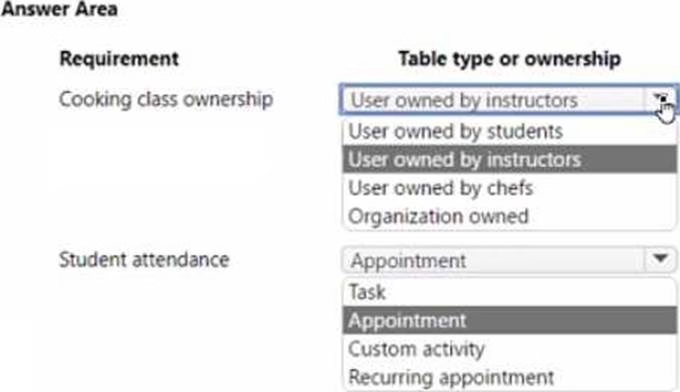
You need to resolve the instructor’s issue and ensure that the same issue does not occur again.
What should you use?
- A . Gallery
- B . Combo box
- C . Custom component
- D . Choices
DRAG DROP
You need to create the food bank notification.
Which four actions should you perform in sequence? To answer, move the appropriate actions from the list of actions to the answer area and arrange them in the correct order.
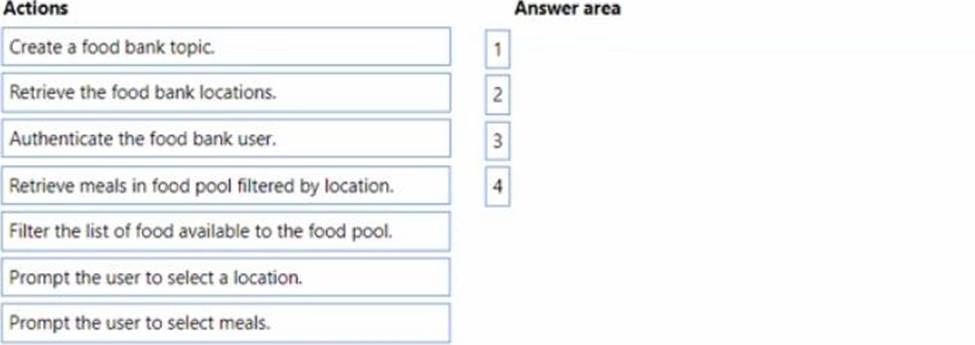
DRAG DROP
You need to select a design approach for the required features.
Which app type should you use? To answer, drag the appropriate app types to the correct requirements. Each app type may be used once, more than once, or not at all. You may need to drag the split bar between panes or scroll to view content. NOTE: Each correct selection is worth one point.

HOTSPOT
You need to design the data model for the cooking classes.
What should you use? To answer, select the appropriate options in the answer area. NOTE: Each correct selection is worth one point.
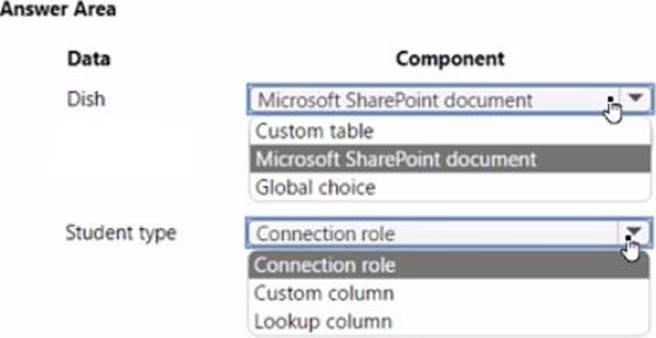
Latest PL-100 Dumps Valid Version with 86 Q&As
Latest And Valid Q&A | Instant Download | Once Fail, Full Refund



